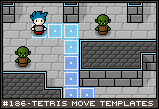|
Mechanic #186 - Tetris Move Templates |
 | Posted: Jan 22, 2014
All movement and attack templates are selected from a limited number of randomly selected shapes. |
![[tetris1.png]](set10/img/entry186-tetris1.png)
Fig 186.1 - Tetris blocks = movement.
This is a relatively simple idea. It's a tactical game in which movement is done by placing Tetris-like pieces on the ground. Each unit's movement is measured not by the number of squares it can move, but the number of Tetris pieces it can link together to create a path. Pieces that cross boundaries are truncated to the boundaries. Then the unit can move to any square in that path.
There's a limited number of Tetris pieces selected at random for each turn, and it is from this set pool that you can choose from. If there are eight pieces each turn and you use two to move one unit, the rest of your units will only have the remaining six pieces to use. So, even though many characters can move 2 pieces each turn, if you selected their full range, you wouldn't be able to move all of them.
![[tetris2.png]](set10/img/entry186-tetris2.png)
Fig 186.2 - Tetris blocks = range.
Tetris blocks don't work so well with ranged weapons that are intended to fire in a straight line. In this case, ranged weapons come with a few line templates that you can place down. You only get to place one, and the set you can use is chosen randomly. Sometimes, you can fire 3 in a diagonal, sometimes only 2. Sometimes you can fire horizontally and diagonally, but not vertically. The pieces are randomly selected from the pool, until they are all used and they are shuffled back into the mix.
Magic attacks work in the same way, but have Tetris-shaped pieces and you can attack anyone in the range (you can cast magic around corners and behind doors).
- I wanted to make a tactical game that didn't rely on the same old move/attack structure. It's true that the randomness of the pieces makes for an unpredictable game, but within that framework there is a tactical structure to work within. Since you have a set pool of pieces for movement each turn, keeping the ones you don't use, you can plan the best movement for your units each turn. You probably won't get the pieces you want every turn, so you need to save the good ones for the right situation, as well as accept the randomness and make due with the tools you have.
You may not get the knight to the perfect spot, but the pieces could be better for the wizard. In fact, one strategy could be to move units into positions that require different pieces to get out of, so that you will always have an optimal move each turn.
There's a weighted randomness to it all. Take ranged attacks. If you know that you've used a particular piece, then you know that, until you've used all the templates, there's no reason to set up an attack position that requires it. As the pool dwindles, you can more accurately predict what templates will come up and plan accordingly. |